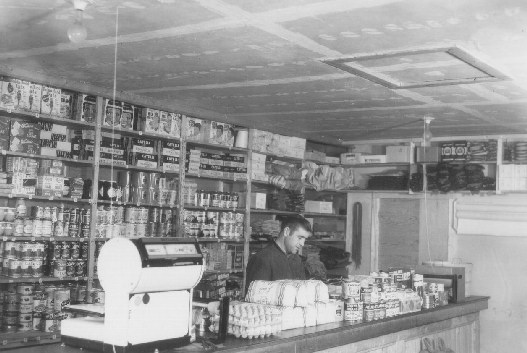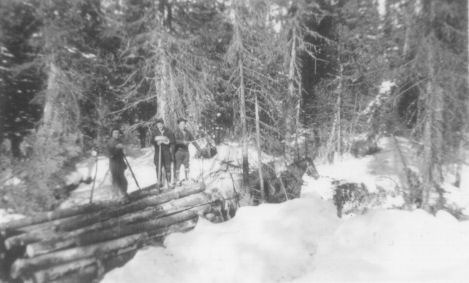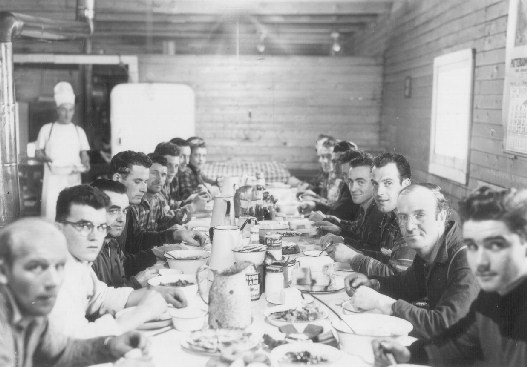


| During
this period, sawmills were built in the bush near logging zones. Mills
could sometimes be moved or owners could install new ones in different
locations.
Because
of their small size, sawmills could be built quickly. Odilon Vachon helped
build several sawmills during the 1940s and 1950s, including J.
D. Levesque's Ritchie mill. "Building a mill did not take long: a carriage,
an edger saw; it only took a month" (Excerpt from an interview with Mr.
Odilon Vachon, Le Nord, September 1, 1976).
|
||
 |
||
|
Behind the counter: Philippe Vachon (Town of Hearst collection; picture donated by Mrs. Rita Lecours) |
||
| Many mills functioned using steam engines, which at the same time produced electricity for camps and other buildings. Some, like the Selin mill, were operated by diesel generators which also generated electricity for the forestry village. | ||
| Work in most sawmills was seasonal, either taking place during the summer or the winter. Paul Després worked 8 years at the Lac Sainte.Thérèse Fontaine mill during the 1940s. "We only worked during the summer. It began early in the spring, when the ice flows left, and ended in the fall, when the water froze again. We worked six days a week, 60 hour weeks. The pay was good for the time. We made up to forty cents an hour" (Excerpt from an interview with Mr. Paul Després in Gens de chez nous, Tome 1, page 82). | ||
| Wood
planing is mainly done during the summer. Similar to sawmills, most planers
were steam-activated. Some were located near sawmills (the Lecours',
for example) while others farther away (Fontaine,
Levesque
and Selin's planers were situated in Hearst),
where the wood was transported.
As with the sawmills, the work that took place in planers was largely manual labour. Simon Nolet worked at the Fontaine planer in Mattice during its last year of operation in 1941, before it was moved to Hearst. "At the time, everything was done by hand. We brought the wood in the planer on our shoulders. We had to hurry and run to the other end to make sure the pieces were end to end, otherwise the wood would have been of poor quality" (Excerpt from an interview with Mr. Simon Nolet, Société historique, 1986). |
||
 |
||
|
(Town of Hearst collection; picture donated by Mrs. Lucie Verreault) |
||
| The
J.
D. Levesque planer practically operated year-round because it was used
by other sawmills.
Logging was carried out starting in autumn and throughout winter, around logging camps (camps with a "cookery" or "batch camps" where lumberjacks had to cook for themselves). Lumberjacks cut timber using bucksaws and similar tools until the mid-1950s when the use of chainsaws became widespread. 12 or 16 foot logs were pulled out using "teams" of horses. Men worked on average 10 hours a day and spent several months in the bush at a time. |
||
 |
||
|
(Town of Hearst collection; picture donated by Mrs. Dolorès Gosselin) |
||
| Mr. René Picard worked as a lumberjack at Fontaine's and later on at Arthur Lecours' Carey Lake mill during the early 1940s. During an interview, he mentioned that lumberjacks were paid $3 per thousand feet at Fontaine's. At Lecours', Mr. Picard claims that some 30 men lived together in camps and had their meals in the "cookery". Meat and beans were served profusely, but meals were diversified. The men went to bed at 9 in the evening and those who worked with horses woke up at 4 in the morning to feed them (Excerpt from an interview with Mr. René Picard, Société historique, Témoins de notre histoire, page 136, 137). | ||
 |
||
|
(Town of Hearst collection; picture donated by Mrs. Rita Lecours) |
||
| At the time, the transportation of logs to mills was done in various ways. At the Fontaine mills (at Fontaine's Landing and Lac Sainte.Thérèse), wood was transported on frozen lakes during the winter using small tractors. | ||
 |
||
|
(picture from the Notre-Dame de l'Assomption Parish souvenir album, 1969) |
||
| Once spring arrived, barges were used to transport logs on the lake. The Lac Sainte.Thérèse mill was located to allow log transportation with the water current using barges. As for the Kabina River mill, logs were first expedited on the river, then by truck. | ||
 |
||
|
(picture from the Notre-Dame de l'Assomption Parish souvenir album, 1969) |
||
| Because work was seasonal, labourers often held different positions along the course of a given year and often changed employers. Claude Jacques worked for many companies (Selin, Canada Forwarding, Gosselin Timber Product, Fontaine) in the late 1940s and early 1950s. During that period he worked as a truck and tractor driver, a lumberjack and a mill worker. "We worked 3 or 4 months and then it all stopped. When the spring thaw came, we couldn't drive anymore so some took up a job in the mill. In the fall, it rained too much: we logged instead of driving" (Excerpt from an interview with Mr. Claude Jacques, LíÉlan magazine, March 1, 1988). | ||

